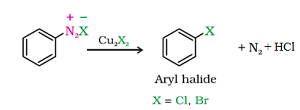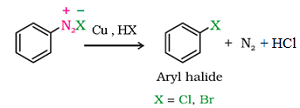
myCBSEguide App
Download the app to get CBSE Sample Papers 2023-24, NCERT Solutions (Revised), Most Important Questions, Previous Year Question Bank, Mock Tests, and Detailed Notes.
Install NowHaloalkanes and Haloarenes Class 12 Notes Chemistry in PDF are available for free download in myCBSEguide mobile app. The best app for CBSE students now provides Haloalkanes and Haloarenes class 12 Notes latest chapter wise notes for quick preparation of CBSE board exams and school-based annual examinations. Class 12 Chemistry notes on chapter 10 Haloalkanes and Haloarenes are also available for download in CBSE Guide website.
Class 12 Chemistry notes Chapter 10 Haloalkanes and Haloarenes
Download CBSE class 12th revision notes for chapter 10 Haloalkanes and Haloarenes in PDF format for free. Download revision notes for Haloalkanes and Haloarenes class 12 Notes and score high in exams. These are the Haloalkanes and Haloarenes class 12 Notes prepared by team of expert teachers. The revision notes help you revise the whole chapter 10 in minutes. Revision notes in exam days is one of the best tips recommended by teachers during exam days.
Download Revision Notes as PDF
CBSE Class 12 Chemistry Revision Notes Chapter 10 Haloalkanes and Haloarenes
- Nature of C-X bond in alkyl halides: X is more electronegative than carbon. So, the C-X bond is polarized with C having a partial positive charge and X having a partial negative charge.
- Preparation of haloalkanes:
a)
b)
c)
d) Halogen Exchange Method:
- Preparation of haloarenes:
a) By elecrophilic substitution reaction:

![]()
b) Sandmeyer’s reaction:


c) Gattermann reaction:

d) From Diazonium Chloride:
e). Balz – Schiemann reaction:

- Physical properties of haloalkanes:
a) Solubility
- Although haloalkanes are polar in nature, yet they are practically very slightly soluble in water.
- In order for a haloalkane to dissolve in water, energy is required to overcome the attractions between the haloalkane molecules and break the hydrogen bonds between water molecules.
- However Haloalkanes are not able to form hydrogen bonds with water and therefore, less energy is released when new attractions are set up between the haloalkane and the water molecules because these are not as strong as the original hydrogen bonds in water molecules.
- As a result, solubility of haloalkanes in water is low.
b) Density
- Simple fluoro and chloroalkanes are lighter than water while bromides and polychlorodevrivatives are heavier than water.
- With the increase in number of carbon atoms, the densities go on increasing. With the increase in number of halogen atoms, the densities go on increasing. The densities increase in the order: Fluoride < chloride < bromide < iodide
- The density also increases with increasing number and atomic mass of the halogen.
c) Boiling Points
- Molecules of organic halogen compounds are generally polar.
- Due to the polarity as well as higher molecular mass as compared to the parent hydrocarbon, the intermolecular forces of attraction (dipole – dipole and van der Waals) between the molecules are stronger in halogen derivatives of alkanes.
- As a result melting and boiling points of chlorides, bromides and iodides are considerably higher than those of the parent hydrocarbon of comparable molecular mass.
- For the same alkyl group the boiling points of alkyl chlorides, bromides and iodides follow the order RI >RBr>RCl> RF where R is an alkyl group. This is because with the increase in the size of the halogen, the magnitude of van der Waals force increase.
- In general, the boiling points of chloro, bromo and iodo compounds increase with increase in the number of halogen atoms.
- For the same halogen atom, the boiling points of haloalkanes increase with increase in the size of alkyl groups.
- For isomeric alkyl halides, the boiling points decrease with branching. This is because branching of the chain makes the molecule more compact and, therefore, decrease the surface area. Due to decrease in surface area, the magnitude of van der Waals forces of attraction decreases and consequently, the boiling points of the branched chain compound is less than those of the straight chain compounds.
- Physical Properties of Haloarenes:
a. These are generally colourless liquids or crystalline solids.
b. These are heavier than water.
c. Melting and boiling points of haloarenes
i. Melting and boiling points of haloarenes are nearly the same as those of alkyl halides containing the same number of carbon atoms.
ii. The boiling points of monohalogen derivatives of benzene are in the order: iodo>bromo>chloro>fluoro
iii. For the same halogen atom, the melting and boiling points increase as the size of the aryl group increases.
iv. The melting point of para isomer is quite higher than that of ortho or meta isomers. This is due to the fast that is has symmetrical structure and therefore, its molecules can easily pack loosely in the crystal lattice. As a result intermolecular forces of attraction are stronger and therefore, greater energy is required to break its lattice and it melts at higher temperature.
- Chemical properties of haloalkanes:
Nucleophilic substitution reaction:

Mechanism of Nucleophilic Substitution Reaction:
SN1 Mechanism
- First order reaction.
- Rate = k [RX] [Nu]
- Racemic mixture
- One step reaction
- Order: CH3X < 10< 20< 30
SN2 Mechanism
- Second order reaction
- Rate = k [RX]
- Inversion of configuration
- Two step reaction
- Order: CH3X > 10> 20> 30
- Elimination reaction: Dehydrohalogentaion(– elimination): When a haloalkane with β-hydrogen atom is heated with alcoholic solution of potassium hydroxide, there is elimination of hydrogen atom from β-carbon and a halogen atom from the α-carbon atom. As a result, an alkene is formed as a product. Zaitsev rule (also pronounced as Saytzeff) is followed.It states that “In dehydrohalogenation reactions, the preferred product is that alkene which has the greater number of alkyl groups attached to the doubly bonded carbon atoms.”
- Reaction with metals:
a) Reaction with Magnesium
b) Wurtz reaction
- Chemical properties of haloarenes:
a) Dow’s Process

b) With halogens

c) With conc. nitric and sulphuric acid

d) On heating with conc. sulphuric acid

e) With methyl chloride

f) With acetyl chloride

g) Fittig reaction:
h) Wurtz – fittig reaction:
i) Other conversions:
CBSE Class 12 Revision Notes and Key Points
Haloalkanes and Haloarenes class 12 Notes Chemistry. CBSE quick revision note for class-12 Chemistry, Physics Math’s, Biology and other subject are very helpful to revise the whole syllabus during exam days. The revision notes covers all important formulas and concepts given in the chapter. Even if you wish to have an overview of a chapter, quick revision notes are here to do if for you. These notes will certainly save your time during stressful exam days.
- Physics
- Chemistry
- Mathematics
- Biology
- Accountancy
- Economics
- Business Studies
- Computer Science
- Informatics Practices
- English Core
- History
- Physical Education
To download Haloalkanes and Haloarenes class 12 Notes Chemistry, sample paper for class 12 Physics, Chemistry, Biology, History, Political Science, Economics, Geography, Computer Science, Home Science, Accountancy, Business Studies and Home Science; do check myCBSEguide app or website. myCBSEguide provides sample papers with solution, test papers for chapter-wise practice, NCERT Haloalkanes and Haloarenes, NCERT Exemplar Haloalkanes and Haloarenes, quick revision notes for ready reference, CBSE guess papers and CBSE important question papers. Sample Paper all are made available through the best app for CBSE students and myCBSEguide website.
- Solid State class 12 Notes Chemistry
- Solutions class 12 Notes Chemistry
- Electrochemistry class 12 Notes Chemistry
- Chemical Kinetics class 12 Notes Chemistry
- Surface Chemistry class 12 Notes Chemistry
- General Principles and Processes of Isolation of Elements class 12 Notes Chemistry
- The p-Block Elements class 12 Notes Chemistry
- The d- and f- Block Elements class 12 Notes Chemistry
- Coordination Compounds class 12 Notes Chemistry
- Alcohols Phenols and Ethers class 12 Notes Chemistry
- Aldehydes Ketones and Carboxylic Acids class 12 Notes Chemistry
- Amines class 12 Notes Chemistry
- Biomolecules class 12 Notes Chemistry
- Polymers class 12 Notes Chemistry
- Chemistry in Everyday Life class 12 Notes Chemistry

Test Generator
Create question paper PDF and online tests with your own name & logo in minutes.
Create Now
myCBSEguide
Question Bank, Mock Tests, Exam Papers, NCERT Solutions, Sample Papers, Notes
Install Now
with increasing carbon in haloalkanes atom density falls
Notes is not perfect defination is not here
hhjhhhiiiiiiiiiiiiiiiiii
not sufficient material!!!!